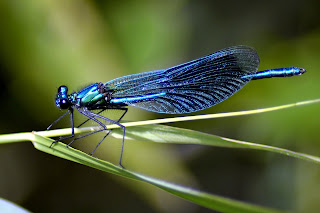 |
| blue dragonfly |
Biology is the scientific study of living things. Biologists define “living things” as all the diverse organisms descended from a single-celled ancestor that evolved almost 4 billion years ago.Because of their common ancestry, living organisms share many characteristics that are not found in the nonliving world. Living organisms:
• consist of one or more cells
• contain genetic information
• use genetic information to reproduce themselves
• are genetically related and have evolved
• can convert molecules obtained from their environment into new biological molecules
• can extract energy from the environment and use it to do biological work
• can regulate their internal environment
This simple list, however, belies the incredible complexity and diversity of life. Some forms of life may not display all of these characteristics all of the time. For example, the seed of a desert plant may go for many years without extracting energy from the environment, converting molecules, regulating its internal environment, or reproducing; yet the seed is alive. And what about viruses? Viruses do not consist of cells, and they cannot carry out physiological functions on their own; they must parasitize host cells to do those jobs for them. Yet viruses contain genetic information, and they certainly mutate and evolve (as we know, because evolving flu viruses require constant changes in the vaccines we create to combat them). The existence of viruses depends on cells, and it is highly probable that viruses evolved from cellular life forms. So, are viruses alive? What do you think? This book explores the characteristics of life, how these characteristics vary among organisms, how they evolved, and how they work together to enable organisms to survive and reproduce. Evolution is a central theme of biology and therefore of this book. Through differential survival and reproduction, living systems evolve and become adapted to Earth’s many environments. The processes of evolution have generated the enormous diversity that we see today as life on Earth.
Comments
Post a Comment